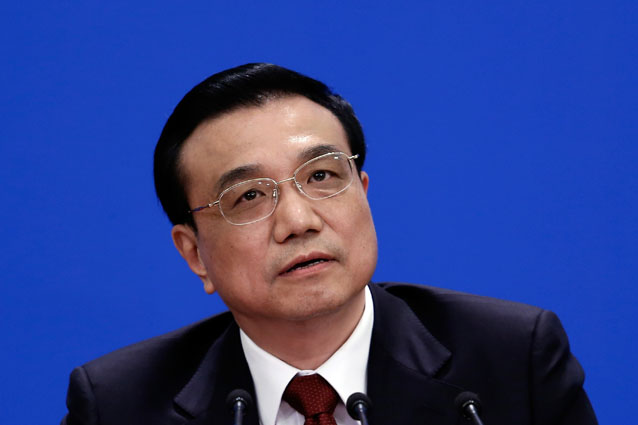Personal Wealth Management / Market Analysis
When the Growing Gets Tough
China’s recent trade data sparked hard-landing fears among investors. But is fundamental weakness really to blame?
Amidst trade wobbles, Chinese Premier Li Keqiang focuses on future growth. Source: Lintao Zhang, Getty Images.
About a month after slowing retail sales and industrial production added to China’s great wall of worry, poor trade data refreshed fears China’s hard landing is nigh. We won’t sugarcoat things: Falling exports and imports probably do indicate China is weakening some, but it’s likely a side effect of officials’ efforts to reengineer and open the economy. Growing pains aren’t pleasant, but they aren’t a crash.
Still, the numbers aren’t pretty. Chinese exports fell -6.6% y/y and imports a whopping -11.2% y/y. Most expected better results (+4.8% y/y and +3.9% y/y, respectively), as March is typically the first month the week-long Lunar New Year holiday—which fell across January and February in 2014—doesn’t skew. Though, exports still faced other distortions, making the year-over-year results seem worse than they really are. In March 2013 exporters filed false custom bills to sneak capital in the country, inflating the official tally and distorting the year-over-year benchmark for March 2014. Because China didn’t crack down until last spring at the earliest, April’s results might not be so rosy either.
Most accepted last year’s customs fraud as the reason exports slid, largely shrugging it off. But imports aren’t so easily explained, and most claimed the drop showed weakness in manufacturing and domestic demand. A fair point—imports detract from GDP, but rising imports usually mean rising demand. A -11.3% fall warranted some raised eyebrows, but the subsequent hard-landing hyperbole seems uncalled for. True, the weak data followed February’s much slower numbers, but adding in January’s (a standard practice to even out Lunar holiday distortions), March’s fall follows double-digit growth in the year’s first two months.
Plus, one month’s decline doesn’t necessarily signal future Chinese data will be weak forever and ever (amen). Q1 Chinese data have wobbled before in overall fine years—one quarter’s growth (or trade data!) isn’t predictive for the other three. Consider 2012, when Q1 rose 1.4% q/q—a big slowdown from prior rates—but sped from there, bringing full-year growth to 7.8%. Same with 2013: Q1 rose 1.5% q/q—down from late 2012—but sped to 1.8%, 2.2% and 1.8% in the next three quarters, and output grew 7.7% in the year. Both times, wobbly Q1 data sparked hard-landing jitters, but officials stepped in with small, targeted fiscal and monetary stimulus, and growth firmed as the years progressed.
2014 seems to be setting up as a sequel (threequel?). As if on cue, officials announced mini-stimulus last week. Like 2012’s and 2013’s measures, it’s a mix of targeted tax breaks and accelerated infrastructure spending in key areas. Small businesses making 100,000 yuan or less will see their income taxes halved through 2016. Officials also plan to pump 1 trillion yuan into building homeless shelters and renovating shantytowns. And new rail construction will grow by 18% y/y this year as tracks expand to less developed areas. Financing will come from a bond issuance of around 350-450bn yuan, versus direct loans—suggesting China’s taking a leaf from developed countries’ playbooks. They’ve even opened a new fund to attract private railway investment. So the stimulus shouldn’t bring banking bloat.
To us, this is all in line with China’s longer-term reform tactics. Flooding trillions of yuan across the economy, like they did in 2009, created huge inefficiencies and fostered corruption—sowing the seeds for many problems China faces today, like over-indebted local governments, manufacturing gluts and occasionally creaky money markets. Instead, targeted stimulus gives officials better control where the money goes and how it’s spent, while staying true to longer-term goals of restructuring and laying a foundation for more lasting growth.
In a speech Thursday, Premier Li Keqiang strongly hinted more stimulus isn’t ahead, suggesting officials are resisting the temptation for a big quick fix. That doesn’t mean they won’t make additional moves if needed—more likely, they’re biding their time, waiting to see if the real economy needs a little more juice. Chinese officials are incentivized to keep growth at reasonably high levels—a big fall could lead to social unrest—potentially costing politicians their jobs. If need be, they’ll probably jumpstart some modest, managed improvement.
But the probability they need to goose growth via bigger spending doesn’t seem high. Plenty of evidence shows China is growing fine, if slower than the robust pace folks grew accustomed to in prior years. State-run manufacturing firms aren’t falling off a cliff, like many suspect. The relatively strong services sector is now both larger and faster-growing than manufacturing, helping buoy domestic demand and indicating the economy is progressing from industry- to consumption-focused, a sign of development. Slower growth is, too. It doesn’t mean China is shrinking—quick or slow, growth compounds. Even expanding around 7% annually—a level developed countries only dream of—China contributes greatly to global GDP, which matters most for stocks.
If you would like to contact the editors responsible for this article, please message MarketMinder directly.
*The content contained in this article represents only the opinions and viewpoints of the Fisher Investments editorial staff.
Get a weekly roundup of our market insights
Sign up for our weekly e-mail newsletter.

See Our Investment Guides
The world of investing can seem like a giant maze. Fisher Investments has developed several informational and educational guides tackling a variety of investing topics.






